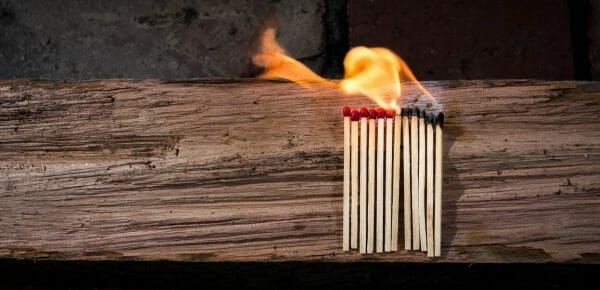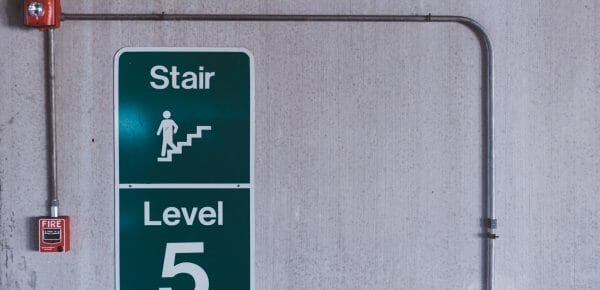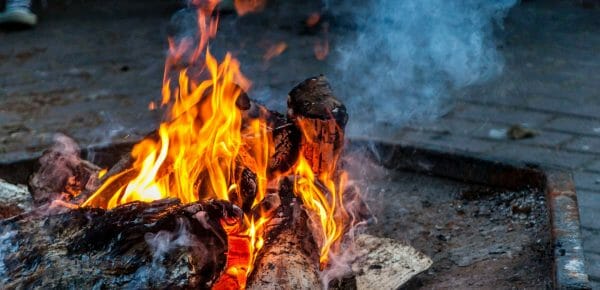Fire safety is a major consideration when designing and building the structures we live, work, and play in. The building materials we utilize have evolved rapidly over the past half-century or so, and we place a much greater emphasis on the way materials react when they come into contact with excessive heat and flames. For this reason, steel has become a natural solution to supporting structures and mitigating the spread of fires.
With all the advances we’ve made in this arena, we aren’t impervious to devastating structural fires. The strongest materials can ultimately fail. Steel fireproofing is an integral part of keeping modern buildings safe and standing for decades to come.
Why steel fireproofing is important
When we think about flammable materials, metals don’t generally cross our minds. Lots of us apply fire directly to the undersides of our pots and pans when we cook meals for our families each day, and they never catch fire. We think of organic matter and materials composed of them as things that are flammable. But, given enough time and heat, nearly anything will burn.
When the flammability of a metal relates directly to our safety, it’s important to address it. Even steel buildings and structures can collapse in the event of a major fire. In order to keep potential fires smaller and more manageable, we utilize both active and passive methods of fire protection.
Active fire protection
Active methods of fire protection are the ones the public is most familiar with. We see a sprinkler system and accessible fire extinguishers, and we know the builders integrated a way to slow the spread of fires and keep the people inside safe. They’ve installed active ways of fighting fires that have already ignited flammable materials. If these methods aren’t enough to stop the fire before it spreads, we rely on passive fire protection methods to slow the spread further.
Passive fire protection
The type of fire protection people are usually less familiar with is passive fire protection. These materials are generally hidden in the structure and the facade and prevent fires from spreading with materials that resist the urge to burn. They are incredibly helpful in providing the time needed to minimize the damage caused by fires.
Fireproofing methods for structural steel
Contractors utilize different methods of steel fireproofing, depending on whether they’re dealing with interior or exterior beams and what the finished product is slated to look like. If the beams will be visible in the finished structure, we treat it a little differently than if it will be hidden. The most common fireproofing methods fall into two categories: Reactive and non-reactive fire protection.
Non-reactive fire protection materials
Non-reactive materials provide fire protection in their natural state. They generally include things like sprays, concrete encasement, boards, and blankets. These types of fire retardant products are used to insulate steel structures by wrapping them in fire resistant materials, and they do not change in size or shape in response to heat.
Sprays
Sprays work well when the appearance of the finished product isn’t particularly important or if the metal beams will be hidden from view entirely. While they aren’t the most attractive surface to look at, they are cost-effective and are a pretty good product for reliable fire protection. They do, however, contain a number of chemicals that are toxic to people and should be applied by professional applicators.
Concrete encasement
An excellent solution for columns, concrete encasement works well in instances where weight is not an issue. As an added bonus, the weight supporting capacity of the concrete may add strength to the overall structure. It’s a less common alternative than it used to be but is still popular in places like parking garages. Rebar may be embedded in the concrete to increase its strength further.
Boards
If the metal structure is hidden from view, you can wrap it in fire-rated rigid board. The boards resist humidity and moisture well and provide some acoustic and thermal benefits as well. This method of steel fireproofing is a good option when you want to install it on the fly, minimizing the number of work hours spent on the project.
Blankets
Another option that works well if the steel beams will be hidden is a flexible blanket system. Flexible blankets are a non-toxic option that is effective at fireproofing steel but is somewhat less practical than other options due to a limited number of manufacturers. If your steel beams present an odd shape, this is an excellent way to provide a good level of protection without having to work around the shape.
Reactive fire protection materials
Reactive materials act much differently than their non-reactive counterparts when exposed to extreme heat. Quite simply, they react. When reactive fire protection materials reach a specified temperature, a chemical reaction is initiated, which causes them to expand and coat the material with a thick layer of fire resistant materials. Intumescent paint for steel is a very popular reactive fire protection material.
Intumescent paint
Intumescent paint is a type of fireproof paint that expands in the presence of extreme heat to provide insulation from fires. It can be applied with a brush or roller, but it’s typically applied with a sprayer. Spraying is the best way to get an even, thin layer applied to the structure.
When it comes into contact with flames, intumescent paint expands until it’s many times its original thickness, protecting the metal from combustion and fatigue for time periods of up to a few hours.
Fire resistant paints like Burn Barrier allow you to leave your steel framework exposed while making it look great and increasing the steel’s fire resistance. It is also flexible enough to shift with the building without losing its pleasant appearance or fire resistant properties.
Prevention is your best bet
It’s great to know that our buildings are designed to slow or even halt the spread of fires, but the best way to protect your property is to prevent fires from igniting and spreading in the first place. You don’t want to put your protective coatings to the test when you’ve got a building full of people. You can take some simple steps to help keep fires from starting or spreading.
Eliminate any possible fire hazards
Flames without fuel will burn out on their own very quickly. Make sure you aren’t creating fire hazards by stockpiling flammable materials in the corner or in utility closets, or near any source of heat or flame. By minimizing the number of areas that could possibly ignite, we reduce the chances we’ll have a fire to fight in the first place.
Keep your fire extinguishers serviced and accessible
Sometimes accidents happen, and so do fires. Always keep fire extinguishers available and easy to get to. It’s a good idea to train at least some of your staff on the proper usage of them, which will save valuable seconds when a small blaze ignites. Be sure your fire extinguishers are rated for the types of fires that may pop up in your environment or industry, and make sure their service records are up to date.
Researching your options
While the lion’s share of steel construction projects still involve larger structures, more and more people are building residential homes with steel beams these days. Utilizing fire retardant products is as important in steel structures as it is in those constructed of more flammable materials.
If you’d like to learn more, reach out to us. We’d love to help. An investment in steel fireproofing is an investment in structural integrity and the safety of your community and is the best way to achieve absolute fire protection for your property.



